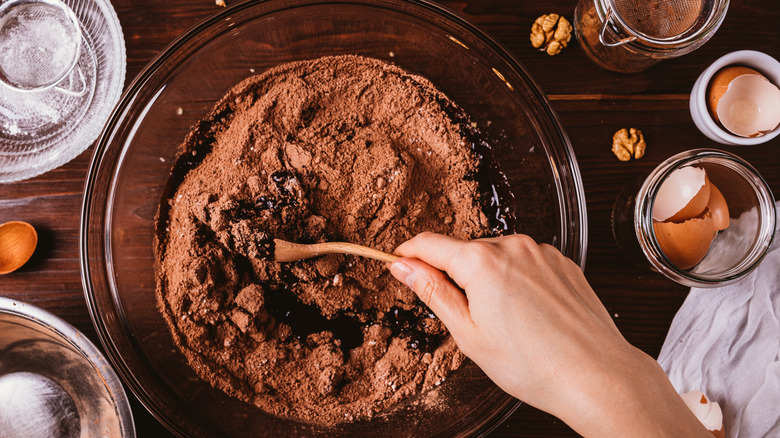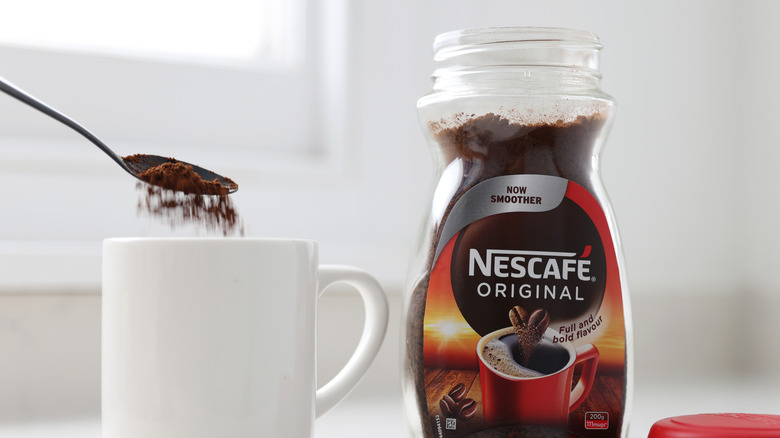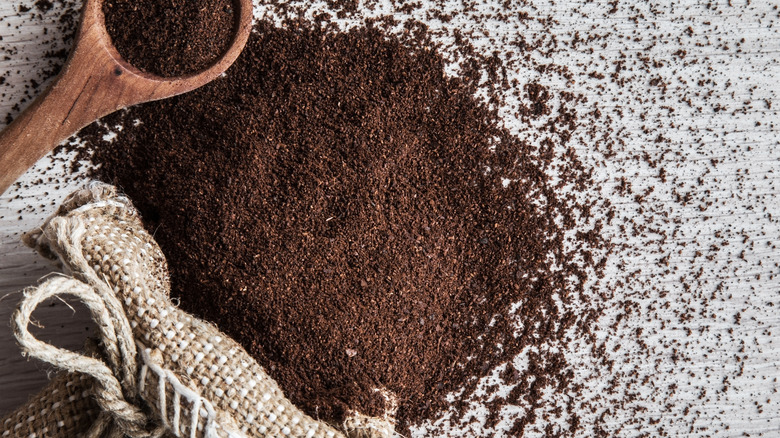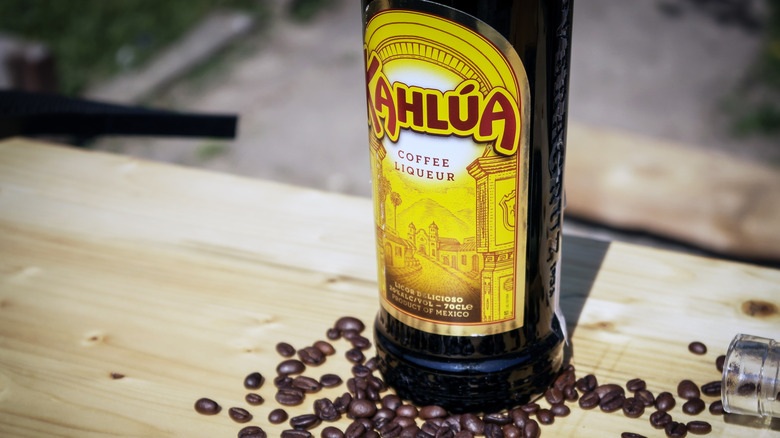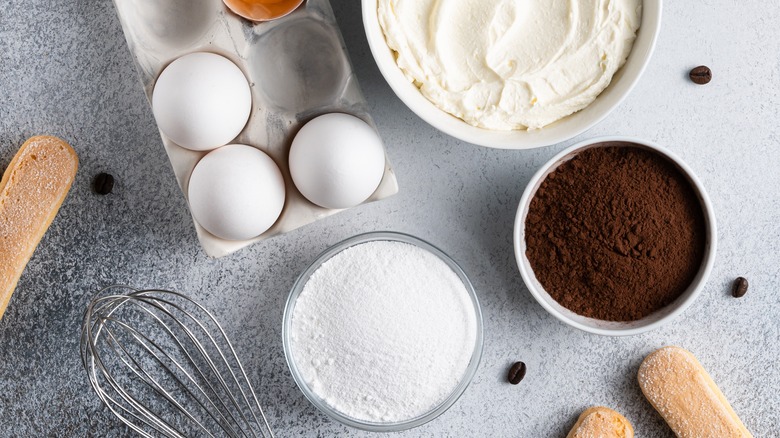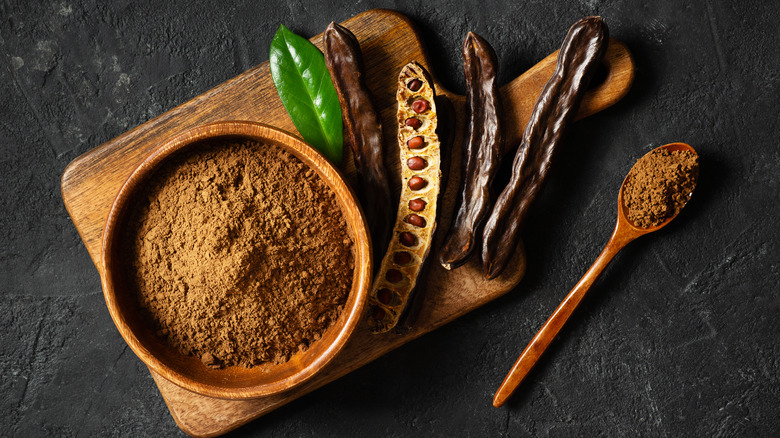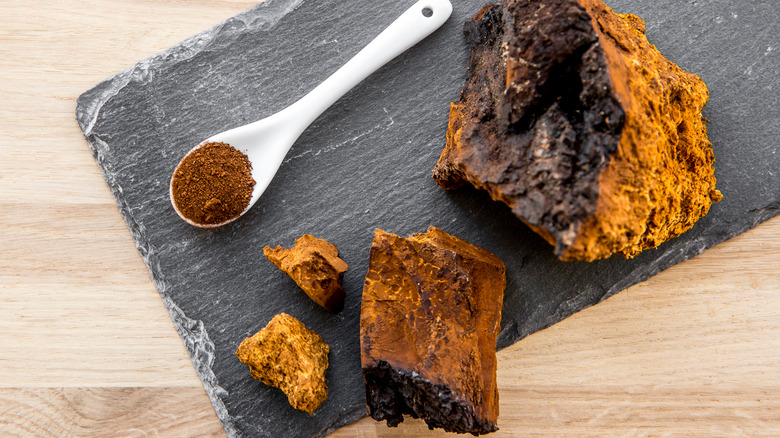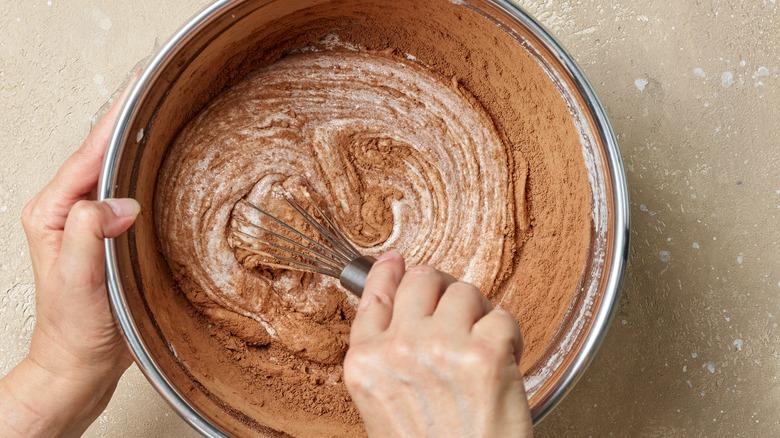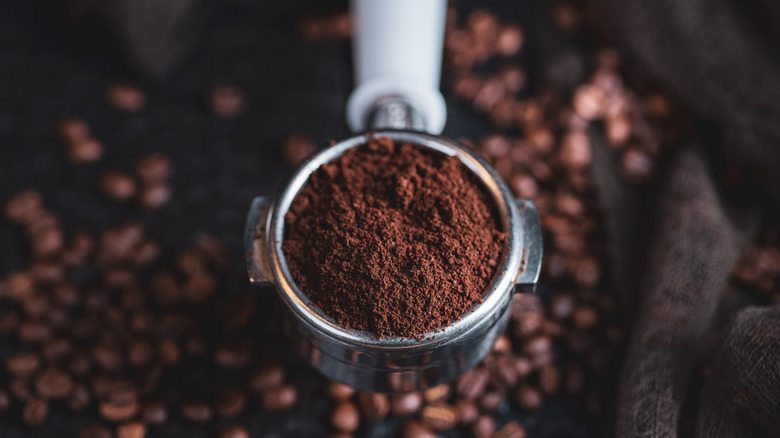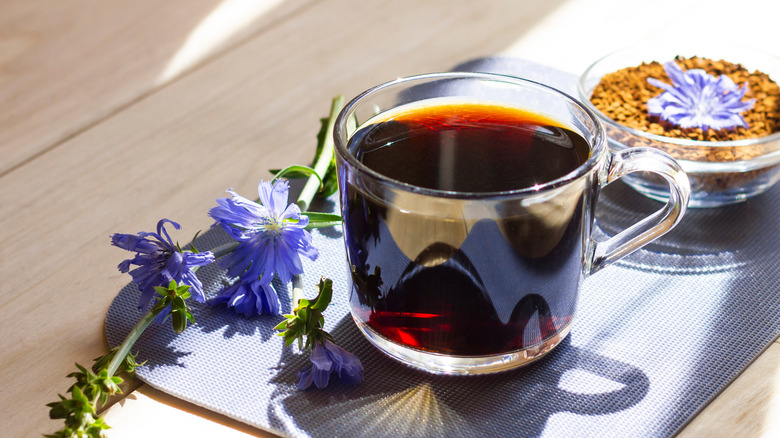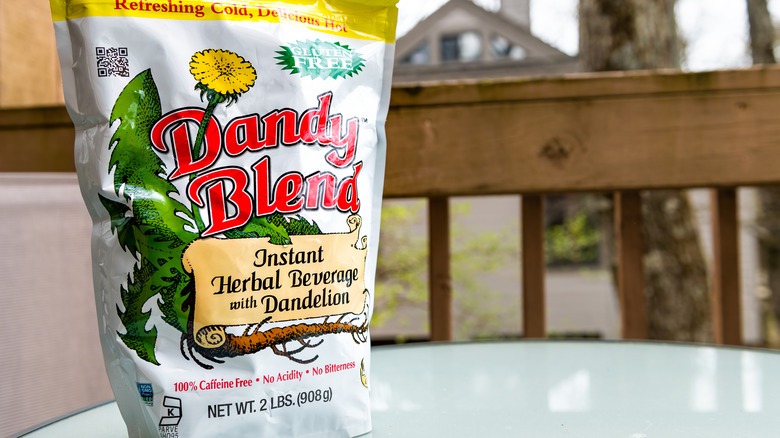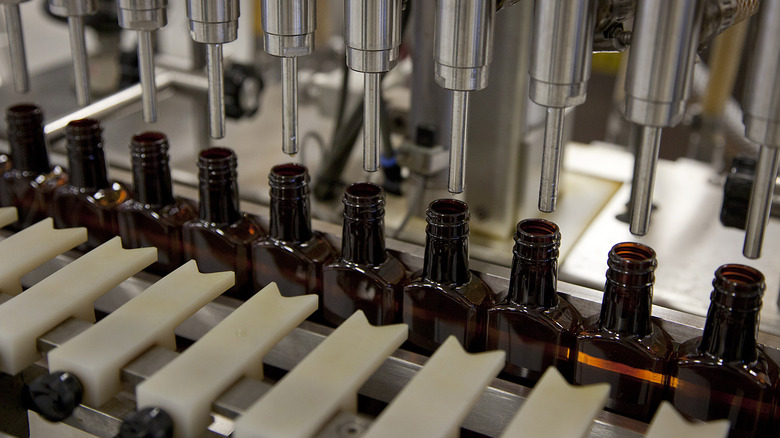13 Substitutes For Instant Espresso In Baking
The average joe enjoys a nice cup of coffee in the morning and a decadent dessert after dinner, but how about combining the two? Both coffee and pastries bring nostalgia and comfort to people worldwide, so it only makes sense that many dessert recipes would integrate coffee, specifically instant espresso. Suppose you're looking to make a dessert with a robust coffee flavor; in that case, you can take advantage of instant espresso because of its sapid properties. On the other hand, if you choose to use small amounts of it, the instant espresso can amplify the flavor of chocolate, according to Delallo.
If you find yourself baking and realize that you don't have instant espresso on hand, it is no problem at all. There are plenty of substitutes that you can use to ensure your dessert has the complexity it deserves. After all, there's a huge variety of coffee alternatives, guaranteeing you'll have access to an excellent option.
Instant coffee
Integrating instant coffee into your recipes rather than instant espresso is a quick and convenient swap. Whether your recipe calls for using dry granules or for you to dissolve the powder into a liquid, using instant coffee as a backup is a good option. However, espresso is generally much bolder than other types of coffee, so you would likely have to adjust your ratio of how much powder you incorporate into your recipe. According to Roasty Coffee, doubling the amount of powder the recipe calls for is a good start when using instant coffee. Luckily, the texture is quite similar to the espresso, so you don't have to worry about the granules ruining the texture of your dessert. With this replacement, there are so many sweets you can make, such as mousses, cakes, ice creams, and more. The only downside is that instant coffee is typically lighter in color than instant espresso. If you're looking for a darker color in your baked goods, you can always add caramel food coloring to make up for it.
Brewed coffee
Not everyone has instant espresso stocked up at their house, but something that is far more common to have on hand is brewed coffee. Fortunately, you can easily use it as an alternative in your baking recipe that calls for instant espresso (via Sobeys). Many recipes are known for using brewed coffee, such as tiramisu. The one possible obstacle to be aware of is that putting too much liquid coffee can make your batter or mixture excessively runny, which can affect the outcome of the finished product. No need to worry, though; there are easy solutions to this. If the recipe you're making calls for water or milk, you can simply swap out the liquid with your brewed coffee; that way, the liquid-to-dry ingredient ratio will stay the same. If you only need a subtle coffee presence in your desert, you can always replace a partial amount of the liquid with your coffee.
Ground coffee
Using ground coffee granules as a substitute for your instant espresso can work depending on what type of dessert you make. If a recipe only calls for a tablespoon or two of espresso, it will be perfectly suitable to use ground coffee instead.
There are two ways you can go about using ground coffee. If you're open to the unique visual appearance of coffee grounds sprinkled throughout your pastry, you can throw the grounds right in the mixture without altering them in any way (via Swift River Roasters). The good news is that using only a small amount means that your dessert won't turn grainy because the grounds will lose their coarseness when baked. On the other hand, if you want the grounds to blend in with the other ingredients visually, you can always grind the granules up further to make them finer. No matter how you approach it, using coffee grounds in your baking will indeed work as a sufficient fill-in for instant espresso, and they will give your dessert the coffee-like flavor it deserves.
Coffee liqueur
For those who are open to using alcohol in their dessert, coffee liqueur offers a rich coffee flavor that can enhance the flavors of your dessert and bring it to the next level. Although coffee liqueur is commonly used in cocktails or coffee, it has many other uses in the culinary world. One significant element about using the liqueur is that you don't need much of it to make its presence known, meaning that it won't affect your cake's ability to rise or your cheesecake's ability to set up. If you wanted to venture out, you could even learn how to make homemade coffee liqueur, which assuredly provides your dessert with a beautiful essence. It can even work in no-bake pastry recipes, for example, by adding a spoonful to your crème anglaise or buttercream. Whatever baking recipe you make, you can be confident in using coffee liqueur as a backup for instant espresso as long as you are up for adding a bit of alcohol.
Dutch-process cocoa
Using Dutch-process cocoa in a recipe for instant espresso is an excellent course of action if you're making a chocolate-based dessert. But how can cocoa replace the flavor of coffee? Interestingly, many recipes don't include coffee for its flavor but rather because coffee enhances the flavor of chocolate, making the chocolate taste more decadent. As reported by the Institute of Culinary Education, Dutch-process cocoa has a deep chocolate flavor. Replacing your espresso with an ingredient like this will give your dessert a bold chocolatey taste, which means that the absence of your espresso powder will not be discernable.
Additionally, the almost-black shade of the powder is comparable to the dark color of the espresso powder, meaning that the final product of your dessert will be a similar color to using instant espresso. The cocoa texture is also worth noting because using it as an alternative will not change the consistency of your confections, making Dutch-process cocoa a solid substitute for instant espresso.
Carob powder
Here is a natural coffee substitute with many of the same properties as instant espresso and cocoa powder. Carob coffee is a common alternative drink to regular coffee, as it is inherently pleasant-tasting and free of caffeine. As stated by Healthline, the source of carob powder is the carob tree. To process, the tree pods are emptied, and then the flesh is dehydrated, pulsed, and turned into granules. In baking, you can use this ingredient to your advantage. According to Liquid Gold, the powder has a fine consistency similar to espresso powder, meaning it won't make your fluffy dessert heavy or dry. Its color ranges from medium to dark brown. You can either throw carob powder into your dessert or dissolve it in hot water before incorporating it. Although carob isn't acidic and potent like coffee, the smooth and chocolate-like taste of the powder will give a wonderful sweetness to your baked goods.
Chaga powder
Another natural stand-in for coffee is drinking Chaga coffee, which is surprisingly made out of mushrooms. But how can a mushroom product replicate coffee in any way? Surprisingly, it is one of the several mushrooms commonly used in mushroom coffee, which have recently become popular. Mushroom coffee, especially Chaga, has a shockingly similar taste to coffee because it has earthy undertones and is slightly acidic. Chaga comes in a powder form, which is excellent for baking because it can be used instead of instant espresso in cupcakes, muffins, and countless other baked goods. Blended drinks and frozen desserts are also excellent vehicles to utilize Chaga powder (via Four Sigmatic). Not only does it have a similar taste to coffee, but Chaga is naturally dark in color like espresso, so the appearance of your baked goods will not be greatly altered by using Chaga as an alternative in your recipe.
Natural cocoa powder
Similar to Dutch-process cocoa, natural cocoa powder can be an excellent replacement for instant espresso in your desserts. Although the natural cocoa powder is lighter in color than espresso, it will surely make up for the lack of color with its rich flavor. Natural cocoa can have a strong taste because of its acidic nature; this is great when comparing it to espresso (via The Washington Post). If you want your dessert to have a deeper chocolate flavor, you can always try blooming it. This means letting the powder soak in one of the recipe's liquid ingredients before integrating it into your recipe. In general, you should bloom cocoa powder to enhance the overall level of sweetness in your desserts, bringing the flavor profiles to the next level. Since the texture and taste of natural cocoa provide similar attributes to instant espresso, it is easy to overlook its lighter complexion. You can always add brown food coloring if it is crucial for your dessert to have an intense and dark color.
Espresso grounds
So, let's say you don't have instant espresso, but you have espresso grounds on hand. Can you use that instead? You certainly can. The significant difference between instant espresso and espresso grounds is that the grounds haven't undergone the brewing process yet, meaning that the flavor is very intense compared to instant forms of coffee (via Fine Cooking). If you are going to use espresso grounds in a recipe as a substitute, it is clever to use less than the recipe calls for in order for it not to overpower your dessert or make it extremely bitter.
Additionally, pulsing the granules to have a softer and lighter consistency will help prevent the final product from being grainy. Nobody wants to eat a chocolate cake that feels sandy, so if your recipe calls for a fair amount of espresso, grinding the espresso grounds is the way to go. Using fine grounds will undoubtedly give your dessert that coffee kick that it needs, and the dark color of the granules is also a benefit because the dessert will look the same visually.
Chicory coffee
Chicory tea, or coffee, is another well-known coffee alternative on the market; it is all-natural and caffeine-free. Consumers enjoy using chicory as a backup for coffee because it is easy to make; chicory grounds are brewed precisely like any other coffee. Regarding flavor, chicory does have a coffee-like taste, with underlying flavors that are slightly different; it can taste somewhat nutty. Chicory powder is made from the root of the plant rather than the stems, as one might assume. To use it in baking, New Orleans Roast states that you can brew it like any other coffee and replace it with a portion of your liquid ingredients that need to go in the mixture. Since the chicory has a subtle sugary taste, it won't make your dessert taste sour or unpleasant. Another plus is that the color of chicory grounds falls on the same spectrum as regular coffee grounds. For these reasons, using ground chicory root as a substitute for instant espresso is a great direction if needed.
Dandy blend
Another impressive coffee alternative on the market is Dandy Blend, a powder made from herbal ingredients, such as roasted barley, rye, dandelion root, and chicory root. Dandy Blend not only offers rich brown color, but its taste is nostalgically similar to coffee. Dandy Blend stands out from other natural coffee substitutes because it doesn't need to be brewed, which makes it similar to instant espresso. It is acceptable to put the dry granules directly into your recipe. However, another option is to mix it in some liquid before adding it to your recipe. Fortunately, you don't have to add it to hot liquid; it can be room temperature or even cold, which makes it a breeze to use (via Dandy Blend). Whether your recipe calls for melted butter or cold milk, throwing your Dandy Blend into either would work sufficiently. The great news is that your baked goods will not be sparse in flavor because the Dandy powder provides a solid and smooth coffee-like taste.
Coffee extract
A fantastic substitute for instant espresso is a coffee extract. Although coffee extract is technically a liquid, it is typically strong in flavor, so a little goes a long way. In most cases, you won't need to reduce the fluids in your recipe to account for the extract because you will only need a splash or two, which isn't enough to affect the liquid-to-dry ingredient ratio. Some baking recipes even suggest coffee extract over instant espresso and other forms of coffee because of how robust the coffee flavor is. The extract is a concentrated liquid with a coffee-like color, so using it will deepen the shade of the frosting, ice cream, or any other sweet you're making, just as instant espresso would (via OliveNation). If you're looking for a quick fix, coffee extract is the perfect solution because it can be added to desserts as is and doesn't require any prep before using it.
Brewed espresso
Similar to brewed coffee, you can conveniently use brewed espresso when making desserts that call for the instant version of espresso. Brewed espresso might be a step above brewed coffee as a fill-in because it is more concentrated and more potent in flavor. Although some may assume that it's a particular bean that makes espresso taste so bold, the untold truth about espresso is that it's actually the process of making it that causes it to be so intense. Therefore, when baking with it, any form of espresso will surely give your dessert the kick that it needs. Depending on the amounts your recipe calls for, you might need to adjust slightly to ensure consistency stays the same and doesn't turn runny, according to Community Coffee. If anything, you can subtract some water or milk from the recipe to account for it. Aside from being aware of any additional liquid you're adding to your recipe, brewed espresso is a solid stand-in with no significant downfalls.
